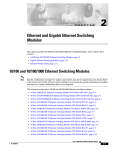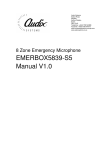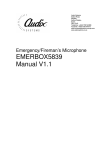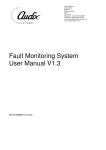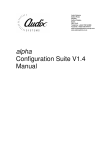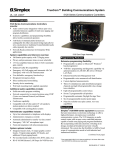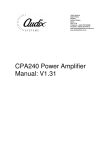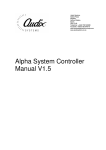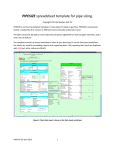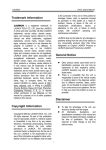Download MSL1000 Fire Alarm System Interface
Transcript
Audix Systems, Station Road, Wenden, Saffron Walden, Essex, CB11 4LG. Telephone: +44(0)1799 540888 Facsimile: +44(0)1799 541618 www.tycosafetyproducts-europe.com www.audixsystems.co.uk MSL1000 Monitored Serial Link Interface Manual V1.01 MSL1000 User Manual 1. Revision History Version 1.0 1.01 Modifications Original issue. Corrections to jumper tables and setup instructions. Date 16/05/01 28/06/01 © COPYRIGHT AUDIX SYSTEMS. 2005 DISCLAIMER This manual contains information that is correct to the best of Audix Systems knowledge. It is intended to be a guide and should be used as such. It should not be considered as a sole source of technical instruction, replacing good technical judgement, since all possible situations cannot be anticipated. If there are any doubts as to exact installation, configuration and/or use, call Audix Systems at +44 (0)1799 540888 ACKNOWLEDGEMENTS All trademarks are recognised Page 2 of 20 21014 V1.01 MSL1000 User Manual 2. Models Covered This user manual covers the following equipment • • • MSL1000 – 16 Channel Monitored Serial Link Interface TPCHASSIS – Terminal Panel Chassis TPMSL100 – Termination Board 3. Technical Support In the unlikely event of you having problems with your MSL1000 please contact our Customer Services Department. Audix Systems Station Road Wenden Saffron Walden CB11 4LG Tel 01799 540888 Fax 01799 541618 Page 3 of 20 21014 V1.01 MSL1000 User Manual 4. Contents 1. REVISION HISTORY ...................................................................................................................... 2 2. MODELS COVERED ...................................................................................................................... 3 3. TECHNICAL SUPPORT ................................................................................................................. 3 4. CONTENTS..................................................................................................................................... 4 5. PROLOGUE.................................................................................................................................... 5 6. MSL1000 OPERATIONAL DETAILS ............................................................................................. 7 DEFINITIONS ......................................................................................................................................... 7 IMPORTANT SAFETY CONSIDERATIONS ................................................................................................... 7 CONNECTIONS TO ALARM CONTROL SYSTEM:......................................................................................... 7 TERMINATION OF SITE CABLES. .............................................................................................................. 8 SETTING ACTIVE STATE OF ALARM INPUTS. ............................................................................................. 8 DE-ACTIVATING UNUSED ALARM INPUTS.................................................................................................. 8 ALARM INPUT TIMING REQUIREMENTS. .................................................................................................... 8 NON-LATCHING OPERATION OF AN ALARM INPUT. .................................................................................... 8 RESET INPUTS: ..................................................................................................................................... 8 RESET PULSE TIMING REQUIREMENTS:................................................................................................... 9 RESET INPUTS OPERATION: ................................................................................................................... 9 SETTING ACTIVE STATE OF RESET INPUTS............................................................................................... 9 DE-ACTIVATING AN UNUSED RESET INPUT. .............................................................................................. 9 OTHER NOTES ABOUT RESET INPUTS. .................................................................................................... 9 HOW THE CONTACTS ARE MONITORED.................................................................................................. 10 MONITORING RESISTORS ..................................................................................................................... 10 MONITORING THE COMMON FAULT OUTPUT WITH AUDIX FMS............................................................... 10 HOW TO LOCATE THE FAULT WHEN COMMON FAULT OUTPUT IS PRESENT. .............................................. 10 W HAT ARE THE VOLTAGES EXPECTED ON THE INPUT WIRES................................................................... 11 EFFECT OF FAULTS THAT DEVELOP SLOWLY.......................................................................................... 11 7. SPECIFICATION........................................................................................................................... 12 8. GENERAL SYSTEM OPERATION............................................................................................... 13 9. RULES OF OPERATION.............................................................................................................. 14 10. TABLE OF JUMPER LINKS..................................................................................................... 15 11. REAR PANEL CONNECTOR PIN-OUTS................................................................................. 17 PIN-OUT FOR MSL1000 FIRE CONTACT MONITORING CARD. D791 PL1 ............................................... 17 PINOUT FOR MSL1000 REAR PANEL TERMINAL BLOCK D791 PL2........................................................ 17 12. SCHEMATIC DIAGRAMS AND PCB LAYOUTS ..................................................................... 18 MSL1000 W IRING SCHEMATIC < ADD A4-93476 ON THIS PAGE WITHOUT ITS BORDER > ............... 18 D791 CONTACT MONITORING CARD..................................................................................................... 19 D792A TPMSL100 CARD ................................................................................................................... 20 Page 4 of 20 21014 V1.01 MSL1000 User Manual 5. Prologue BS 5839 describes a requirement for ‘the voice-alarm system to latch on reciept of a signal from the fire detection and alarm system until de-latched by a seperate command from the fire detection and alarm system’. The Audix MSL1000 is a serial data linked interface for Audix PA VA systems that satisfies this requirement, with a dc monitored parallel interface for volt-free contacts driven by any fire detection and alarm system. This document descibes the intended operation and use of the MSL1000. The operating principle is to define the contact loop resistance with resistors in serial and parallel with the contacts, at the contact location. Then with a DC current drive to the contact loops, monitor the DC voltage with “window detectors” at the voice-alarm system inputs Only when the detectors “see” a voltage between the “HI” and “LO” voltage threshold do they pass on the alarm signal to the voice-alarm equipment, the alarm signal is “active high” The HI and LO threshold levels are programmed with jumper links at two alternative levels to allow monitoring of NO or NC alarm contacts Two fault conditions will cause a fault to be detected: 1. Open-circuit when the monitored voltage exceeds a reference level 2. Short-circuit when the monitored voltage falls below a reference level The MSL1000 must be linked to the Master Fault Monitoring System (FMS) which will report faults detected by the unit. The detector is designed signal a fault condition to the FMS if power to the unit is lost The Output connections of the interface are linked to the serial 485 interface card and housed into a single 19” rack mountable, 1U chassis. This connects the alpha, Vector or V32 front-end audio processors, which contain the emergency message cards. The data link between the MSL1000 and alpha or Vector is continuously monitored and its failure is reported to the master FMS. Whenever the fire alarm contact activates the MSL1000 will send data to the alpha or Vector and trigger the emergency fire message. Messages are stored as raw data files and not as simple tone generators, so any voice and/or alarm message can be recorded and stored on the message cards. Priorities and routing of messages can be configured within the alpha, Vector or V32 matrix Page 5 of 20 21014 V1.01 MSL1000 User Manual Page 6 of 20 21014 V1.01 MSL1000 User Manual 6. MSL1000 operational details Definitions The Unit Output MSL1000 Monitored Serial interface An active high level to the serial to parallel convertor which is transmitted by the serial link card D439. LED on is the non-alarm state, the input opto-coupler holds the input low, with high being the active (alarm) state tranmitted by the MSL1000 to the Alpha or V32 or Vector or similar Voice Alarm System controller. Alarm Input A dc monitored connection from the fire detection and alarm system, used to activate the Audix Voice Alarm system Reset Input A dc monitored connection from the fire detection and alarm system, used to de-latch the alarm state of the Audix Voice Alarm system. Fault Output 5V Logic level output from the unit, not driven high in fault condition. Fault State An input deemed to be short-circuited or open-circuited, as detected by the fault monitoring circuits, and thus not able to control a programmed alarm response. Important Safety Considerations The MSL1000 should be supplied from a fuse protected 24V DC supply, the fuse rating should be 500mA L T. The MSL1000 and associated equipment must not be exposed to dripping or splashing. Connections to Alarm Control System: The unit will require the following connections to isolated contacts at the fire detection and alarm system. 1. One wire per Alarm signal. 2. One wire for a Common Reset. 3. One wire common 0V return. All inputs feature filter/delay circuits to eliminate false triggers. Figure 1. MSL Schematic (Non Phased Evacuation) Figure 2. MSL Schematic (Phased Evacuation) Page 7 of 20 21014 V1.01 MSL1000 User Manual Termination of site cables. A ribbon cable from the main MSL1000 chassis connects to a special Termination Panel fitted to a rail in the the rear of the equipment rack. This panel is Audix 2 Systems part TPMSL100 and allows connection of site cables up to 2.5mm . There are extra terminals and another ribbon cable connector on the TPMSL100 to accomodate the System Fault outputs from an Audix Systems FMS system. The terminal block arrangement is shown in a later section of this manual, for easy installation it is silkscreened on to the PCB just below the terminal blocks. Setting active state of alarm inputs. For all inputs the operational active state will be collectively programmed as ‘normally open’ or ‘normally closed’ using jumpers. Fit J1, J3/1-2, leave J2 open for NC mode. or Fit J2, J3/2-3, leave J1 open for NO mode. Each input in use, should have its ‘Input Active’ jumper fitted to provide monitoring current: Fit J12 for input 1, J22 for input 2, J32 for input 3 etc. There is a complete listing of all the jumpers later in this manual. De-activating unused alarm inputs. Any input not in use, should have its ‘Input Active’ jumper removed. Remove J12 for input 1, J22 for input 2, J32 for input 3 etc. In the open or unjumpered state, the input will be inactive, and must not be programmed as part of the alarm system. No connection should be made to the input terminals, if a monitored contact is accidentally connected then a fault will be indicated. Alarm Input timing requirements. The Reset Input should be inactive before an Alarm Input changes to the active state. The Fire Detection system should maintain the Alarm Input(s) in an active state, for the duration of the alarm period. To cancel the alarm, the Alarm Input is deactivated immediately before a reset pulse is applied at the reset input. See “General System Operation” a later section of this manual, for a description of operation with a Fire Alarm system. Non-latching operation of an Alarm input. The second jumper link on each input channel allows latching mode to be defeated for that input. In general these links will not be fitted on BS5839 compliant systems. For non-latching operation fit J11 for input 1, J21 for input 2 non, J31 for input 3 etc. Reset Inputs: There are two reset inputs, operation of each is identical. Page 8 of 20 21014 V1.01 MSL1000 User Manual The Reset Input should be driven (with a pulsed signal) by the fire detection and alarm equipment. Reset Pulse Timing requirements: The Reset Input should be driven to its active state for 2 seconds minimum, following the change of state of any Alarm Input from active to inactive state. Reset Inputs Operation: When Reset inputs are in the inactive state, or in a recognised fault state; each output will become active when the associated input connection goes into activate state. When the Reset inputs are in the inactive state, or in a recognised fault state ; any active output will remain active, even if the corresponding alarm input goes into a faulty state. The Reset Input will be ineffective when in s/c fault state, or in o/c fault state. When a Reset Input is in a recognised fault state it will not be possible to silence the alarms by deactivating the alarm inputs. An active Output will remain active if its Input is active and a Reset input is active An active Output will remain active if its input goes directly into a fault state, while the Reset Input is in inactive state or fault state. Setting active state of reset inputs. The active state of the Reset Inputs follows the collectively programmed state for the alarm inputs (i.e. ‘normally open’ or ‘normally closed’ using jumpers.) The reset inputs in use must have thier ‘Input Active’ jumpers fitted: Fit J301 if Reset Input 1 is in use, fit J311 if Reset Input 2 is in use. De-activating an unused reset input. The unused reset input should have its ‘Input active’ jumper left open. In the open or unjumpered state, the input will be inactive, and no connection should be made to the input terminals. If monitored contact is connected then a fault will be indicated. Remove J301 if Reset Input 1 is not used. Remove J311 if Reset Input 2 is not used. Other notes about reset inputs. The second monitored Reset input may optionally be wired to a manually operated switch or to key-switch on the front panel of the unit or at some remote location. When a Reset Input is held in the Active State the operation of the unit will appear non-latching. This is just how it works but is not the best way to achieve overall non-latching operation. If non-latching is is required it is recommended to disable the reset inputs and select non-latching operation for all of the alarm inputs as described earlier in this manual. Page 9 of 20 21014 V1.01 MSL1000 User Manual How the contacts are monitored. Each input, including reset inputs will monitor its input connection for o/c and s/c failure. Each input has 4 states, defined by voltage levels: o/c fault, s/c fault, active, and inactive. Any Input detecting a fault state will cause an active low signal on the ‘common fault’ output from the unit. Each input connection must be fitted with the specified monitoring resistors located at the fire detection equipment end of the connection. Failure of any or the power rails within the unit will cause an active low signal on the ‘common fault’ output from the unit. Any Alarm or Reset input that is deactivated ( no jumper fitted) will cause a common fault output, if monitor resistors are connected to the input terminals. Monitoring resistors Specified end of line resistors, as supplied with MSL1000: R in series with contacts: 910Ω 1% 100ppm 0.3W metal film R in parallel with contacts: 3KΩ 1% 100ppm 0.3W metal film Figure 3. MSL Wiring Details This gives the following resistance readings: Switch Closed state circuit resistance = 910 Ω. Switch Open state circuit resistance = 3.91 kΩ ( 910Ω +3.0 kΩ) Control Line Short Circuit =0Ω Control Line Open Circuit =∞Ω Monitoring the Common Fault Output with Audix FMS. The Common Fault output should be monitored using an input of a Audix VT704 card in an Audix FMS. The VT704 should be set to indicate a fault when the common fault output drops below 4.0 Volts. The input pull-up resistor on the VT704 must be disconnected with the appropriate jumper link setting. If the Common Fault output is used to drive Fault Monitoring Systems other than Audix FMS be aware that this output does not sink current in the fault state when power fails to the MSL1000. How to locate the fault when common fault output is present. As the diagnostic LEDs are not visible when the chassis is closed, the easiest way to identify faulty inputs is to measure the voltages on the input terminals with a DC voltmeter. Page 10 of 20 21014 V1.01 MSL1000 User Manual What are the voltages expected on the input wires. Each input has 4 states, defined by voltage levels: o/c fault, s/c fault, active, and inactive. Contact Status Fault condition Alarm/Active Idle/inactive Fault condition Input voltage range: N.C. mode Over 12.3V 6.7 V to 12.3V Nominal 5.4V Less than 4.0V Input voltage range: N.O. mode Over 12.3V 4.0V to 8.0V Nominal 10.4V Less than 4.0V The voltages in the table assume the onboard regulator is exactly 15 Volts. If the regulator gives a different voltage within its expected tolerance range then the thresholds which are derived from this voltage will vary pro-rata. Effect of faults that develop slowly. Certain slowly developing faults may be seen as temporary false alarm signals, these will of course latch if the Reset Input is in inactive state or fault state. In practice an s/c fault is more likely to develop slowly than a o/c fault; a typical cause of this problem is moisture soaking into a badly sealed mineral insulated cable. A false alarm will not normally be generated when a fault warning is given for a slowly developing s/c fault if the Fire Alarm Interface is operated in Normally Closed mode, although the idle current is slightly higher in this mode. A decision must be made during system design which mode of operation best suits the application. The monitoring circuitry is designed to avoid another problem associated with Normally Closed mode; The leakage current on the cable should trigger a fault condition before it becomes too large to prevent the voltage reaching the alarm threshold should the contact open to signal a true alarm signal. The voltage thresholds are set differently in NC mode specifically to avoid this problem. Another problem addressed in the design is the effect of a slowly developing fault on a reset input, which may pass through the reset active state, during which time the latching operation would be ineffective. This is why it is most important for the alarm inputs to be maintained during alarm conditions, as described in the general system operation section, this then gives the system the greatest immunity from failure to generate an alarm. Page 11 of 20 21014 V1.01 MSL1000 User Manual 7. Specification Alarm inputs . 16 Reset inputs 2 Input activation collectively programmed. Either NO or NC Inputs individually programmable Active or Disabled Inputs individually programmable Latching or Non-latching Input connection monitoring. O/C and S/C failures. Alarm is not activated by inputs detecting faulty input connections. Certain slow faults excepted. RS485 interface to VA matrix PMCV 16 protocol. Single Logic level fault O/P Driven high for no faults. (greater than 4V) Fault output, high state source current 6 mA at 4V o/p Fault output low state sink current ( with power failed ) 0 mA Front panel fault indicators. None Internal diagnostic LEDs per alarm input: Input in fault state. Internal diagnostic LEDs per reset input: Input in fault state. Internal diagnostic LED: Reset input active, one LED for both reset inputs. Power supply voltage required: 20 – 28V DC 24V DC recommended In normal idle state the MSL1000 with all inputs active: 200mA from a 24V Power supply protection fuse rating. 500mA L T Power consumption: 5W max. Page 12 of 20 21014 V1.01 MSL1000 User Manual 8. General System Operation Figure 4. Timing Diagram For Single Message Operation Figure 4 Shows a simple single message system, The fire alarm panel switches the contact which activates the voice alarm message to be broadcast. The fire panel should maintain the contact for the duration of the alarm condition. When the alarm contact is deactivated. The fire panel must pulse on the reset line for 2sec (nominal) which will switch off the alarm message. Figure 5. Timing Diagram for Multiple Message Operation Figure 5 shows a system with Alert and Evacuation Messages. As with the previous system the Fire panel switches an alarm contact which activates the voice alarm to broadcast the Alert message. Some time later the fire panel switches the evacuation contact. Due to the matrix having priorities on each message the Evacuation message (which is a higher priority than the alert) will now be broadcast. As before the fire panel must maintain the contact for the duration of the alarm. To stop the broadcast of messages. The fire panel must deactivate the alarm contacts, and pulse the Reset line for 2 seconds. Page 13 of 20 21014 V1.01 MSL1000 User Manual Figure 6. Zoned Evacuation Timing Diagram Figure 6 shows a multi-zoned evacuation system with both Evacuation and alert messages. The fire panel switches the alert contact for zone 1. This causes the Alert message to be broadcast to zone1 . Some time later the fire panel switches the alert contact for zone 2. The alert message will now be broadcasting to both zone 1 and 2. After this the fire panel switches the zone to Evac, Due to the priority in the matrix the Evacuation message over rides the alert and is broadcast to zone 1, the alert message will still be broadcasting in zone 2. Some time after this the Evac and Alert from zone 1 are deactivated b the fire alarm, the reset should be pulsed on for 2 second to stop the broadcast of message to zone 1. As the Zone 2 Alert contact is still activated during the reset for the zone 1 contacts. The output state will not change and the alert message will still be broadcast to zone 2. Finally when the zone 2 alert is deactivated by the fire panel the reset contact must be pulsed to stop the alert broadcast to zone 2. 9. Rules of operation. 1) The fire panel should maintain the contact for the duration of the alarm condition 2) Whenever an output form the Fire Panel is switched to the non alarm state, the reset output must be pulsed for 2 seconds. Page 14 of 20 21014 V1.01 MSL1000 User Manual 10. Table of Jumper links. J12 J22 J32 J42 J52 J62 J72 J82 J92 J102 J112 J122 J132 J142 J152 J162 Activate input 1 Activate input 2 Activate input 3 Activate input 4 Activate input 5 Activate input 6 Activate input 7 Activate input 8 Activate input 9 Activate input 10 Activate input 11 Activate input 12 Activate input 13 Activate input 14 Activate input 15 Activate input 16 Fit if input is used. J11 Non-latching input 1 J21 J31 J41 J51 J61 J71 J81 J91 J101 Non-latching Non-latching Non-latching Non-latching Non-latching Non-latching Non-latching Non-latching Non-latching 10 Non-latching 11 Non-latching 12 Non-latching 13 Non-latching 14 Non-latching 15 Non-latching 16 Open for latching mode. mode. J111 J121 J131 J141 J151 J161 J1 NC mode J3/2-3 NC mode J2 NO mode input 2 input 3 input 4 input 5 input 6 input 7 input 8 input 9 input Open if input not used. Fit for non-latch input input input input input input Fit if interfacing with Normally Closed contacts Open if interfacing with Normally Open contacts Fit if interfacing with Normally Closed contacts Open if interfacing with Normally Open contacts Note This is labelled wrongly as NO on PCB iss.B Fit if interfacing with Normally Open contacts Open if interfacing with Normally Closed Page 15 of 20 21014 V1.01 MSL1000 User Manual J3/1-2 J301 J311 NO mode Activate Reset 1 input Activate Reset 2 input contacts Fit if interfacing with Normally Open contacts Open if interfacing with Normally Closed contacts Note This is labelled wrongly as NC on PCB iss.B Fit if Reset 1 is used. Open if Reset 1 not used Fit if Reset 2 is used. Open if Reset 2 not used Page 16 of 20 21014 V1.01 MSL1000 User Manual 11. Rear panel connector pin-outs Pin-out for MSL1000 Fire Contact Monitoring card. D791 PL1 Pin/ Cor e 1 2 3 4 5 6 7 8 9 10 11 12 13 14 15 16 17 18 19 20 21 22 23 24 25 26 Signal name Description 0V 0V IP 1 IP 2 IP 3 IP 4 IP 5 IP 6 IP 7 IP 8 0V 0V IP 9 IP 10 IP 11 IP 12 IP 13 IP 14 IP 15 IP 16 0V 0V RES_1 RES_2 spare 25 spare 26 Common 0V return Common 0V return Monitored contact input 1 Monitored contact input 2 Monitored contact input 3 Monitored contact input 4 Monitored contact input 5 Monitored contact input 6 Monitored contact input 7 Monitored contact input 8 Common 0V return Common 0V return Monitored contact input 9 Monitored contact input 10 Monitored contact input 11 Monitored contact input 12 Monitored contact input 13 Monitored contact input 14 Monitored contact input 15 Monitored contact input 16 Common 0V return Common 0V return Monitored Reset Input 1 Monitored Reset Input 2 Spare wire to terminal panel Spare wire to terminal panel Pinout for MSL1000 Rear Panel Terminal Block D791 PL2. Pin/ Cor e Signal name 1 2 3 4 5 6 0V 24V /FAULT D+ D– Data SCR Description (Note: Pin 1 is LHS viewed from REAR of MSL1000) 0V DC supply return (BLACK) 24V DC supply input (RED) Logic Level Fault Output (>2.5V = OK, <2.5V = FAULT) Data Signal +ve (GREEN) Data Return –ve (YLW) Page 17 of 20 21014 V1.01 MSL1000 User Manual 12. Schematic Diagrams and PCB layouts MSL1000 Wiring schematic Page 18 of 20 21014 V1.01 MSL1000 User Manual D791 Contact Monitoring Card Page 19 of 20 21014 V1.01 MSL1000 User Manual D792a TPMSL100 Card Pinouts for TPMSL100: 10W ribbon cable for FMS Fault outputs Pin/Core Signal Description 1 NF_NC New Fault contact (NO when relay not powered) 2 NF_W New Fault contact (Wiper) 3 NF_NO New Fault contact (NC when relay not powered) 4 SF_NC System Fault contact (NO when relay not powered) 5 SF_W System Fault contact (Wiper) 6 SF_NO System Fault contact (NC when relay not powered) 7 ACC Fault Accept contact i/p 8 0V OV return for Accept contact 9 == +5V == = DO NOT CONNECT = Internal 5V rail used for test jigs Page 20 of 20 21014 V1.01





















